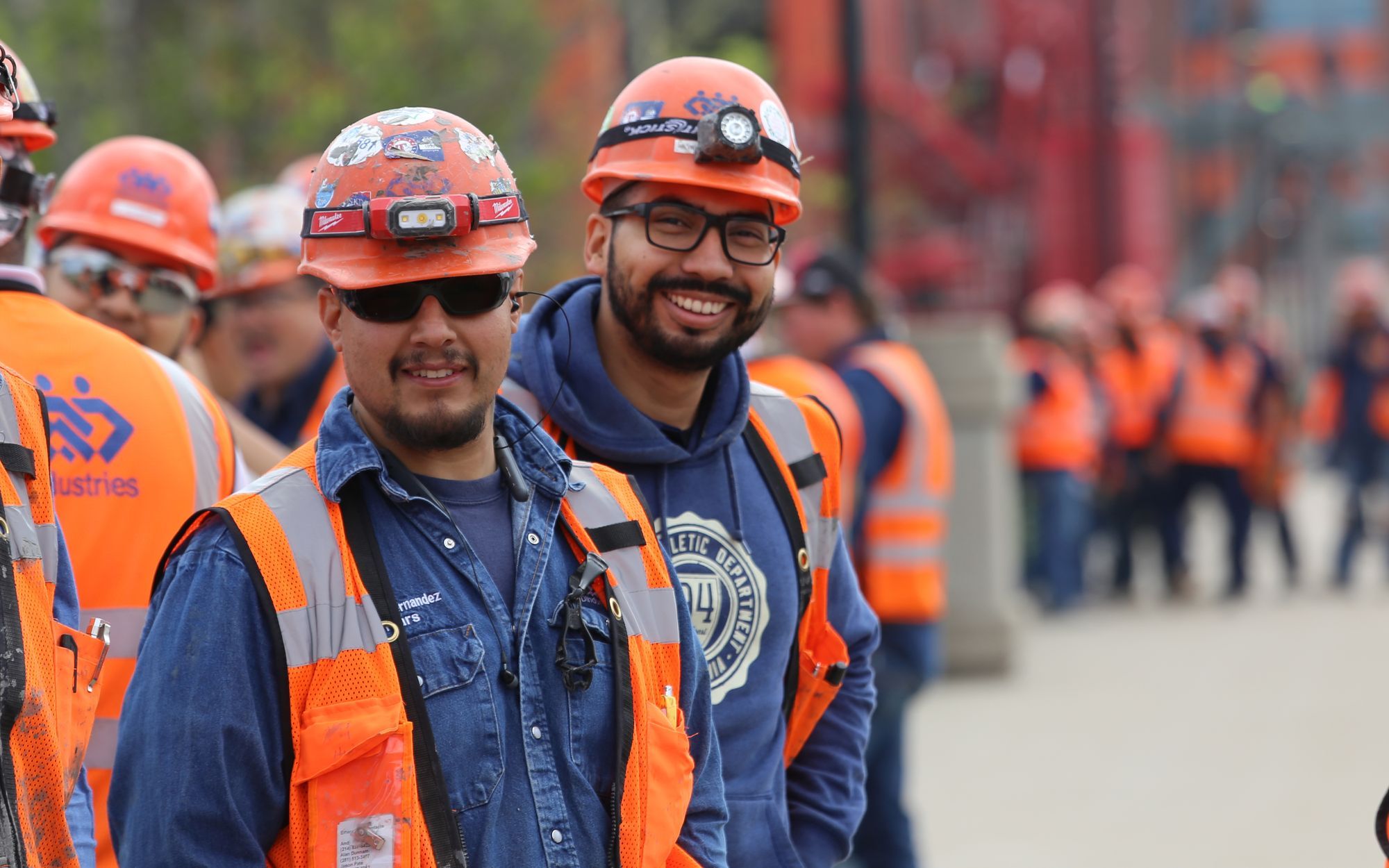Many contractors today are urgently transforming their recruiting practices to attract the right kind of worker. That’s because productivity has taken a huge hit in today’s red hot economy as worker numbers dwindle in an ever-tightening labor market.
The problem is being exacerbated by the growing number of retiring baby boomers. By some estimates, about 10,000 of them are reaching age 65 every day. Unfortunately, the wake they’re leaving behind can’t be filled by the much smaller Generation X.
Fluor focuses on the upward mobility of its employees
and encourages them to expand their skillsets. The
company incorporates gaming technology, such as
augmented reality and virtual reality, to attract
and train workers in pipefitting, welding, electrical and
instrumentation at its training center in
Pasadena, Texas.
Contractors aren’t sticking their heads in the sand. They recognize that millennials are the likely sole solution to today’s labor woes and are taking important and necessary steps to attract them to the industry.
Andy Williams, director of talent acquisition at TDIndustries in Dallas, tailors some of the company’s recruiting activities specifically to reach the 20- and 30-somethings. He says one of the ways that’s done is by keeping abreast of the latest technologies and means of communication. “Everyone has a mobile phone in their hand, and that phone has become the go-to device for connecting,” Williams says.
As such, this Southwest company has integrated phone apps into its work processes—TextApply and TextRecruit—that allow the company to easily establish a conversation with potential recruits through keyboard-based “regular” texting and automated text prompts. The company also incorporates the text feature into its applicant tracking system, thereby avoiding long gaps in communication and instant access to communication history.
Founder and CEO Dan Puente at DP Electric Inc in Tempe, Arizona, foresaw the growth in labor demand a few years ago, so he hired a recruitment and talent development manager (Steve Brown) and intensified his company’s marketing and branding efforts. “We made the decision to create a recruitment team and instructed them to work cohesively with our marketing team,” Puente says. All stages of the recruitment process at DPE were also modernized with new technology in response to shifting market dynamics.
The changes have been overwhelmingly successful. In 2014, the contractor onboarded more than 200 people over a two-month period using an applicant tracking system that significantly simplifies the application process. Applicants can also have a conversation with a web-based recruiting assistant 24/7.
Industrial mega-contractor Fluor in Sugar Land, Texas, utilizes social networking, talks to local high schools and partners with local associations to attract workers. “We’re always planning for the best strategy in a highly variable market,” says Mark Truchan, Fluor’s global HR director.
TAPPING INTO A TIGHTENING SUPPLY
TD gets about 40% of its new hires through referrals and provides financial incentives to encourage its partners to participate. “It keeps turnovers in check, because people typically are going to refer people with staying power,” Williams says.
Dallas-based TDIndustries is an employee-owned
company, where 30 percent of all profits are distributed to
participating partners through retirement plans.
The company took the extra step of hiring a dedicated program manager to build and grow relationships. Since the hire, TD has participated in more than 180 recruiting events, including job fairs, industry, community and school events, veterans initiatives and women-in-trades events. The company also manages a robust internship program targeting high school and college students.
The success of their efforts, however, all hinges on the follow up. “Other recruiters will trot out to a high school, put up a table, spend the day and then go back to their day jobs,” Williams says. “That relationship never grows legs and doesn’t take off. For others, it’s just an idea and it becomes a check-the-box activity, but at TD, building and maintaining trusting relationships is one of our core values.”
DP Electric’s Brown says it’s important for contractors to tell a “cohesive story” that resonates with all generations entering the workforce.
“We help them understand what they’re going to do and how it’s going to correlate to the big picture,” Brown says. “They want to know where they fit into that picture.”
Truchan credits Fluor’s success to its focus on upward mobility. “We’re all about progressing people through their careers,” he says. Fluor uses a proprietary tool to track employee training and certifications to ensure they’re given access to more opportunities and that their skillsets are portable across multiple Fluor business lines. That, Truchan says, appeals to the younger workers. “It’s exciting to them when they can go from a power job in Florida to a life sciences program building in North Carolina. It provides a chance for a welder, for example, to expand his skillset with Fluor’s help.”
Steering workers toward jobs that are in constant or increasing demand is important, as competition for workers is intensifying to unprecedented levels. According to the Construction Industry Institute, the industry could include up to seven million workers by 2030.
TELLING YOUR STORY
The ability to attract and retain employees is often impacted by a contractor’s image, both inside and outside the company. In a somewhat non-traditional manner, DP Electric frequently changes its branding based upon evolving market dynamics. That way, they get their message “to the right people in the right place at the right time,” Brown says. “We’ll change what that looks like every six months, or even on the fly if we find something that’s not working.”
Branding is equally important to the construction industry as a whole. That’s why Puente serves on the steering committee for Build Your Future Arizona, a program hoping to change the industry’s image. The committee has raised some $1.5 million that will fund a marketing campaign.
Williams says TDIndustries promotes a servant-led culture and focuses more on “getting recruiting right” than “time to fill” statistics, a more common measuring stick. “As a result, we have some of the industry’s lowest turnover rates,” he says.
Beverly Bailey, CEO/president of Stronghold Engineering Inc. in Riverside, California, says her company’s values are anchored in a teamwork-oriented culture. “It’s grounded in a company-wide foundation of mutual respect,” Bailey adds. “We’re looking for individuals who want an opportunity to grow in their career path and be part of our future. We can do a lot with smart, humble and hungry individuals who are looking for a home.”
TRAINING IS KEY
Recruiting is more than simply competing for workers over wages. TDIndustries pays fairly, but also offers a robust training program and a well-defined pathway for mobility. That way, everyone in the organization knows their current role and future potential. “If the employer believes that it all boils down to pay rates, then they’re missing the connection between candidates and people, and what they offer as an organization,” Williams says.
At TDIndustries, personal growth is not a suggestion but an expectation. The company requires 30 or more hours of training from its partners every year and supports that financially. In fact, the company recently established the 24,000-square-foot TDExchange in Arlington after seeing a need for a centralized facility to serve its North Texas operations. The facility provides a place for repairing tools, sharing experiences, learning trade skills and developing best practices. It’s less than 10 blocks from TD’s most recognizable current project—the Texas Rangers’ new stadium, Globe Life Field.
Beyond its warehouse capabilities, the Exchange includes 12,000 square feet of training space dedicated to field leadership meetings and hands-on craft education, supporting some 30-plus partners at a time. In addition, partners can practice on specialized equipment and learn installation techniques for specific projects.
DP Electric similarly empowers its employees through education and training. Much of that is done at DP University, which offers classes to both employees and those outside of the company. Nine instructors teach at the apprenticeship level after work and on Saturdays. The company hopes to eventually open up the training to high school kids and others wanting a job in construction, specifically the electrical industry.
Fluor leans heavily on gaming technology, such as augmented reality, to attract and train workers in pipefitting, welding, electrical and instrumentation at its training center in Pasadena, Texas. In three years, the contractor has trained more than 500 people at the facility.
Virtual welding machines also teach advanced skills that help onboard workers more quickly and affordably. “Before we spend large amounts of money on materials to train a welder, we can teach them indoors and get them to the necessary competency level,” Truchan says.
“Part of our mission statement is personal and professional growth,” Puente says. “If our employees are growing as individuals, their growth is the company’s growth.”







